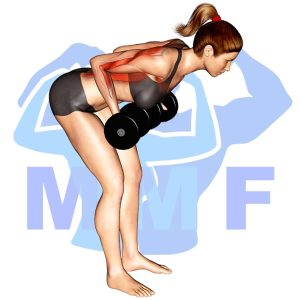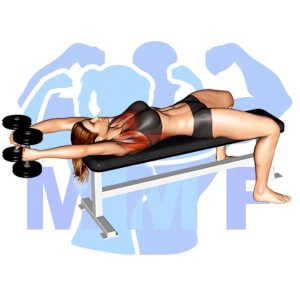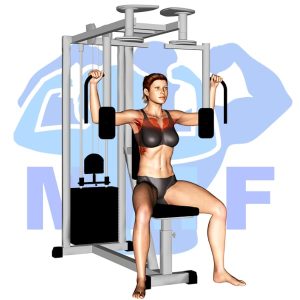Are you struggling with strengthening your back muscles? Do you find it hard to do exercises such as pull-ups or chin-ups? If so, you might be battling with an inadequate upper body strength. Many people face these issues, and it’s understandable why it can be discouraging. However, one essential exercise that can help you overcome these physical limits is the inverted row. In this post, we will discuss how the inverted row can benefit your upper body strength and guide you through the proper technique to maximize its benefits.
Inverted Row Summary
- Primary Muscles: Deltoid – Posterior
- Secondary Muscles: Brachialis, Brachioradialis, Pectoralis Major – Sternal
- Equipment: Barbell and Rack
- Mechanics Type: Compound
- Force: Pull
- Utility: Basic or Auxiliary

Inverted Row Instructions
- Lay on your back under the fixed horizontal bar.
- Grab the bar with a wide overhand grip.
- Keep your body straight. Pull your body up to the bar.
- Return until by extending your arms and shoulders.
- Continue your Inverted Row for a complete set.
Video Tutorial
Inverted Row Muscles
Target (Agonist)
- Deltoid – Posterior
- Erector Spinae
- Infraspinatus
- Latissimus Dorsi
- Rhomboids
- Teres Major
- Teres Minor
- Trapezius
Synergists
- Brachialis
- Brachioradialis
- Pectoralis Major – Sternal
Dynamic Stabilizers
- Biceps Brachii
- Triceps – Long Head
Stabilizers
Antagonist Stabilizers
- None

Benefits of Inverted Row
The inverted row is an effective exercise for strengthening the posterior deltoid muscle. This exercise targets the back of the shoulder, helping to develop strength, stability, and improve posture. The inverted row is also beneficial for improving shoulder mobility and range of motion, which can help reduce the risk of shoulder injury. Additionally, this exercise can also help build strength in the core and upper back muscles, increasing overall muscular endurance.
Tips for Performing Inverted Row
You’ve landed at the right location if you desire to forge ahead your capability to conduct inverted row. These tips can allow you to benefit fully from this first-class exercise and make the best of its results. Concurrently with shaping your upper back muscles, improving movability, and also a reduced possibility of injury can all be accomplished with this exercise. Let’s get begin and look at what these tips can accomplish for you.
- Make sure to keep your body in a straight line during the exercise – This will ensure that you are using your back muscles to the fullest and avoiding any injury.
- Make sure to squeeze your shoulder blades together at the top of the movement – This will help strengthen your back and give you more control over the motion.
- Keep your breathing steady throughout the exercise – This will help you maintain proper form and avoid straining your body too much.
Benefits and Tips Video
Frequent Mistakes To Avoid
Staying away from errors can be the difference between a productive workout and a painful injury when executing inverted row. Additionally, to maximize your benefits of the exercise, proper form is required. Through preventing these common mistakes, you may improve your performance and get the results you want. But relax, it’s not as challenging as it might seem. By knowing the errors to avert and taking the appropriate actions, you can execute the activity securely and successfully. Let’s start by avoiding these typical errors and add this exercise to your training regimen.
- Not engaging the core muscles: Many people make the mistake of not engaging their core muscles while performing an Inverted Row. This can cause them to not get the full benefit of the exercise and can potentially lead to injury.
- Going too low: Another mistake people make when doing Inverted Rows is going too low, which can strain the back muscles and put too much stress on the body.
- Not using proper form: Using improper form when performing an Inverted Row can lead to incorrect muscle activation and can cause strain and injury. Taking the time to practice proper form is key to getting the most out of this exercise.
Find More Bodyweight Exercises Here
Variations and Complementary Exercises
There are several variations, complementary, and alternative exercises that can be done to work the same muscles as the Inverted Row. These can be used to add more variety to your workout, or they can be done when an Inverted Row isn’t possible. Let’s take a look at some of the exercises you can do instead of an Inverted Row.
Reverse Grip Bent Over Dumbbell Row

The Reverse Grip Bent Over Dumbbell Row is an excellent complementary exercise to the Inverted Row. It is a pulling exercise that works the same muscles as the Inverted Row, but with a different emphasis. It primarily works the upper back and biceps, while also working the shoulders and core muscles. It is an effective alternative exercise to the Inverted Row because it allows for a greater range of motion and works the muscles in a different way. The Reverse Grip Bent Over Dumbbell Row also requires more balance than the Inverted Row, further engaging the core muscles and providing a more challenging workout.
Bent Over Rotating Dumbbell Row

The Bent Over Rotating Dumbbell Row is a complementary or alternative exercise for the Inverted Row. This exercise is done by holding a pair of dumbbells in each hand, bending forward at the hips, and then rowing the weights back up to your chest while rotating your arms outwards. This exercise targets the back muscles, as well as the biceps, shoulders and core muscles. The Inverted Row is an excellent exercise for developing upper body strength, but the Bent Over Rotating Dumbbell Row adds an additional challenge to the workout by requiring the use of stabilizing muscles throughout the movement. This variation also allows you to work each arm independently, which can help improve muscular balance and symmetry.
Bent Over Dumbbell Row

The Bent Over Dumbbell Row is a great complementary or alternative exercise to the Inverted Row. This exercise targets the same muscles, including the lats, biceps, and rear deltoids, and requires a similar strength and stability from the core and lower body. To perform the Bent Over Dumbbell Row, stand with feet shoulder-width apart and lean forward at the hips while holding a pair of dumbbells. Pull the dumbbells up to your sides, keeping your elbows close to your body and squeezing your shoulder blades together at the top of the movement. This exercise is an effective way to build strength and balance in the upper body while providing a slightly different challenge than the Inverted Row.
Check Out These Top Bodyweight Exercises
Seated Underhand Cable Row

The Seated Underhand Cable Row is a great complementary or alternative exercise to the Inverted Row. This exercise works the same muscles as the Inverted Row, such as the lats and rhomboids, but from a seated position. To perform this exercise, sit on a bench with a cable row machine and grasp the handle with an underhand grip. Keeping your back straight and your core engaged, pull the handle towards your abdomen and slowly return to the starting position. This exercise is great for strengthening your upper back, shoulders, and arms.
Dumbbell Lateral Raise

The Dumbbell Lateral Raise is an effective exercise to work the shoulder muscles and is a great complement or alternative to the Inverted Row. The Dumbbell Lateral Raise focuses on the lateral deltoids, which are the muscles on the outside of the shoulder. To perform this exercise, you start by standing with your feet shoulder-width apart and a dumbbell in each hand. Then, raise the dumbbells up to shoulder height with your palms facing the ground. Be sure to keep your elbows slightly bent and keep your chest up throughout the movement. This exercise not only helps build strength in the shoulder muscles, but it also helps improve posture and stability.
Dumbbell Straight Arm Pullover

The Dumbbell Straight Arm Pullover is an excellent complementary or alternative exercise to the Inverted Row. It targets the same primary muscles as the Inverted Row, including the lats, rhomboids, and lower traps, while also providing a greater range of motion. The Dumbbell Straight Arm Pullover also works the chest and core muscles more than the Inverted Row does, making it a great exercise for strengthening the entire upper body. Additionally, the Dumbbell Straight Arm Pullover can be done with a lighter weight than the Inverted Row, making it more accessible to those who may not have access to heavier weights.
Find More Back Exercises Here
Opposing Complementary Exercises
Performing exercises that work the opposing muscle groups is an effective way to maximize your workout and prevent injury. These exercises will help you build a strong, balanced physique and improve your overall strength. Here are some exercises that complement the exercise Inverted Row by using opposing muscle groups:
Close Grip Push Up On Knees

The Close Grip Push Up On Knees is an excellent complementary exercise to the Inverted Row. This exercise primarily works the triceps, which are the opposing muscle group to the back muscles worked in the Inverted Row. It is important to have a balanced upper body workout and doing these two exercises together will help you achieve this. The Close Grip Push Up On Knees will help to strengthen your triceps and give you more control and strength when doing the Inverted Row.
Close Grip Push Up

The close grip push up is a great exercise to complement the inverted row, as it works the opposing muscle group. This exercise focuses on the chest, triceps, and shoulder muscles. It involves placing your hands closer together than a regular push up and pushing yourself up and down. As the inverted row works the back, biceps and core, this exercise provides an effective countermovement for more balanced development of the upper body. With regular practice, you will be able to build strength and endurance in both exercises.
Lever Pec Deck Fly (Machine)

The Lever Pec Deck Fly machine is an excellent tool to complement the exercise of Inverted Row. By using the opposing muscle group, this machine will help strengthen the chest and back muscles. The Lever Pec Deck Fly works by having the user sit in the seat and grab the handles while pushing them away from each other, simulating a pec fly movement. This movement helps to strengthen the chest and can be used to increase the difficulty of Inverted Row exercises. The Lever Pec Deck Fly is a great way to ensure that both the chest and back muscles are getting an equal amount of attention, ensuring that an even and balanced physique is achieved.
Row Your Way to a Stronger Back
If you want to strengthen your back, give inverted rows a try. This exercise focuses on the muscles in your upper back, shoulders, and arms, making it a great addition to your upper body workout routine. The best part about this exercise is that you don’t need any fancy equipment or a gym membership to do it, making it a great option for those working out at home. By incorporating inverted rows into your workout, you can improve your posture, reduce your risk of injury, and build a stronger, healthier back.
References: Wikipedia | ExRx.net | PubMed.gov | Comprehensive List of Back Bodyweight Exercises

